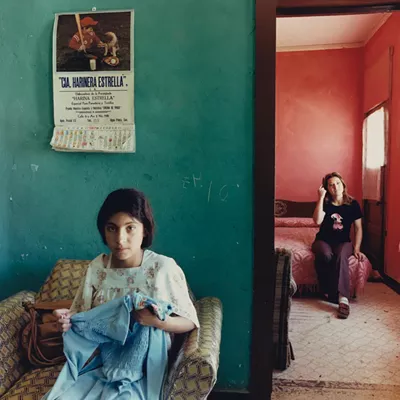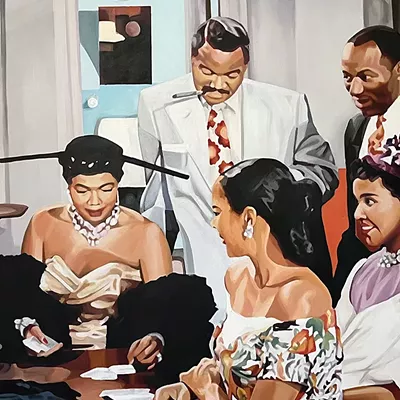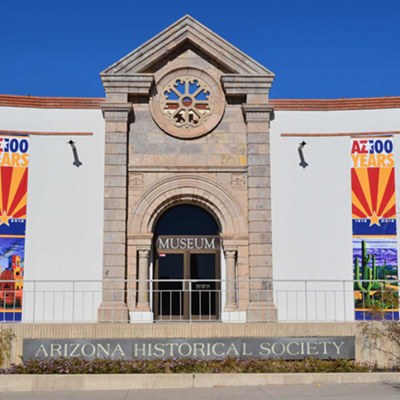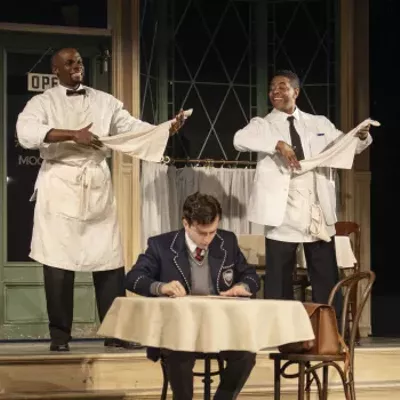Certainly pretty pictures of the landscape can be sappy and portraits of brave soldiers sentimental, but then abstract art at its worst can be equally non-threatening, its canvases mere compilations of colored shapes. That's why corporations commandeer the more insipid abstractions for their waiting rooms.
At its best, abstraction challenges the status quo, throwing the proverbial pot of paint at the face of the public. But so does the best realism, as Come Rain or Shine: 20th Century American Realism, the big summer show at the University of Arizona Museum of Art, bears witness.
"Illegals," a 1985 lithograph in black and white by the incomparable Luis Jimenez, is a case in point. The picture makes heroes out of the wretched of the earth, the desperate people whom U.S. immigration policies are driving to their deaths. It's a black night along the border in Jimenez's work, but a sliver of a moon shines benevolently on a cluster of refugees struggling over a hill. Car lights break through the darkness, too, but their origin is uncertain: Perhaps it's the dreaded Migra, the U.S. Border Patrol; perhaps it's the rescuers who will speed the migrants away from danger.
Jimenez uses his art to make deadly clear his point that these fleeing people, the future cleaning ladies and busboys of America, are persecuted heroes. (The poet Demetria Martinez calls them pilgrims.) Jimenez puts a woman in a Mexican shawl, and a man in a straw campesino hat, but he never adheres to strict representation, instead loosely sketching the figures in his typical exaggerated style. He nonetheless positions them in the heroic triangle composition, the classic European device used by, say, Géricault in "The Raft of the 'Medusa.'" Jimenez's figures rise up, monumentally, out of the earth. "Illegals" is a powerful piece of work, made all the more so by the excruciating deaths last month of 14 Mexicans in the bone-dry desert near Yuma.
Not all the art in the show is political, of course. There's at least one of the pallid pretty pictures mentioned above--Edward W. Redfield's "The Canal," a piece of American Impressionism from 1912--and even a solider returned home, in Norman Rockwell's undated "Willie Gillis." But the most interesting works in this big show, all gathered from the museum's own collections, document the respectable history of political art in this country. There's even a companion piece to Jimenez's migrants. Lloyd Moylan's 1942 watercolor "From Shiprock to Shonto" places Navajos in the same triangular composition, posed majestically in their own landscape. While it doesn't carry the same up-to-the-minute political message, it subversively makes heroes of a group of people at the lowest rung in American life.
The social criticism begins with a 1916 illustration from the socialist magazine The Masses. George Wesley Bellows' lithograph "Benediction in Georgia" pictures a self-satisfied preacher blessing the hapless prisoners in a Southern jail. And it goes all the way up to Sue Coe's 1990 "End of the Empire," a vehement condemnation of animal slaughter. Rendered in graphite and gouache on paper, this colorful painting annihilates the Farmer John meat company, depicting a porcine holocaust taking place behind its cheerfully painted walls. (A real-life Farmer John, in all its mural glory, is on West Grant Road just east of I-10). A stunning painting by Hung Liu, a Chinese painter living in California, doesn't exactly fit the American theme but evidently curator Peter S. Briggs judged that it was too powerful to leave out. The beautifully painted "Still Life," an oil on canvas from 1991, pays tribute to the Tiananmen Square uprising, arranging a sitting phalanx of police face to face with a hunger striker.
The show avoids the question of whether photography must be a slave to realism by leaving it out altogether, and concentrates its energies instead on paintings and works on paper. (Thanks to the diligence of Peter Bermingham, the museum's late director, the UAMA is a stronghold of prints and paintings on paper.) One work, "Sawdy," a 1971 screenprint by Edward Kienholz, even incorporates the front door of a Datsun, but this is a mixed-media exception to the show's painterly and printed rule. Sprinkled in with the lesser-knowns are quite a few famous names, Leon Golub, Fritz Scholder, Edward Hopper and Thomas Hart Benton among them.
In fact, the strongest groupings of works are from the late 1920s through the 1940s, when Hopper and Benton and their confrères offered competing visions of urban and rural America. Hopper is the more respected nowadays, for his dismal view of the anomie of modern American cities. "The City," a 1929 oil on canvas, is a typically stark work. Seen from a vantage point of a window high above Washington Square, New York stretches out in an infinity of monotonous rooftops. The constructed city leaves no room for nature, and very little comfort for human beings. Down below, faceless city dwellers trudge through the blankness of the square, the monolith of red-brick townhouses blocking any escape.
Other city artists lionized their own ethnic groups, snubbed by the larger metropolis. Frank DiGioia offers a delightful view of New York Italian life in "Fish Market," a gouache from 1940-41; Samuel Koch painted "Orchard Street" in 1934, curiously transforming the Lower East Side's rowdy Jewish life into somber queues of docile buyers, hemmed in by claustrophobic architecture. The anthropologist of the upper classes, painter Reginald Marsh, offers social caricature worthy of a Daumier in "Monday Night at the Metropolitan," a 1936 tempera and oil on masonite. The grimaces of his rich ladies and gentlemen at the opera are priceless.
While all these urban realists were trying to make sense of the dramatic rise of the American city, Benton, king of the regionalists, was toiling unfashionably in the heartland. Benton is dismissed in more than one art book as "mawkish." Indeed, there's a touch of sentimentality in his reverence for the land and its people, though his wartime "Letters from Overseas," depicting a farmwoman reading a missive, perhaps from her husband, is more sweet than sentimental. And works like the 1939 lithograph "Cradling Wheat" offer an original vision of the landscape, not to mention a commendable compassion for the little guy that comes close to that of an artist as politically radical as Jimenez.
Benton lovingly distorts American's curves, gleefully turning gentle hills into rollercoaster arcs, topsy-turvy and bounteous. The men bringing in the sheaves in "Cradling Wheat," bending over into their task, are straight out of Millet, the 19th-century French realist painter who disturbed the Academy by finding the sacred in the profane peasantry.
In Benton's art, agriculture still is a labor by hand. (His contemporary, Joseph Jones, shows farm wagons still being drawn by mules in his 1942 "Harvest.") Benton's Midwestern yeomen of 60, 70 years ago have been replaced by corporate agribusiness; if they're not yet entirely gone, they'll soon be as extinct as Millet's peasants.
If Benton's most famous student Jackson Pollock gets the highest praise (and, belatedly, the movies), Benton himself leaves a small but sturdy legacy. He gives us a piece of lost time, a vision of a vanished America. Perhaps even more importantly, this realist gives us a picture of what the nation, at mid-century, still idealistically believed it was, all Hopper's lessons to the contrary: a democracy of sturdy citizen-farmers.













